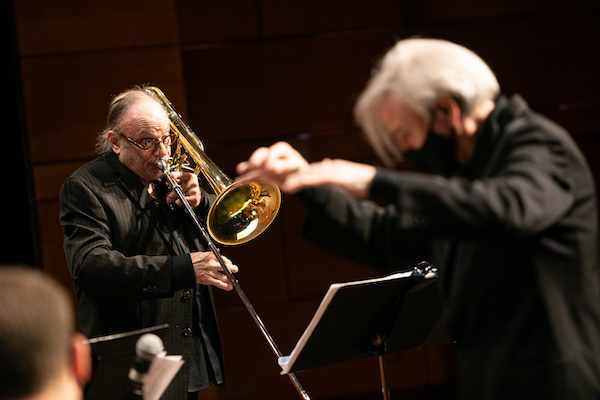PostClassical Ensemble misses the mark in bizarre Mahler melange

Trombonist David Taylor performed in the PostClassical Ensemble’s Mahler program led by Angel Gil-Ordóñez Wednesday night at the Kennedy Center’s Terrace Theater. Photo: Daniel Schwartz
The PostClassical Ensemble attempted another heavy lift for its latest program, heard Wednesday night at the Kennedy Center Terrace Theater. A chamber-sized ensemble of fourteen musicians, conducted energetically by Angel Gil-Ordóñez, took on the grand orchestral music of Gustav Mahler. The intentions were good, but the results left much to be desired.
Concert producer Joseph Horowitz explained that the focus of the concert was Mahler’s incorporation of Jewish musical ideas into his symphonies and songs, heard first in excerpts and then in a complete symphony. The clearest example was the opening item, an excerpt of the folk-music passages that crash into the stately third movement of Mahler’s First Symphony. A mock-solemn funeral march, the piece was possibly inspired by a fanciful woodcut by Moritz von Schwind, depicting a hunter’s burial cortege composed of animals.
With no trumpets and only two percussionists, this lively music, often thought to evoke a klezmer band, lost some of its zing. Clarinetist Garrick Zoeter and oboist Fatma Daglar crowed convincingly. The march, itself based on the children’s song “Bruder Jakob,” returned briefly, but the excerpt concluded before Mahler’s quotation of his own song “Die zwei blauen Augen” (from Lieder eines fahrenden Gesellen).
Instead we then heard the first song from that collection, “Wenn mein Schatz Hochzeit macht,” as the forlorn narrator weeps alone in his room on his beloved’s wedding day. (Perhaps Mahler’s use of that Jewish folk band music in the First Symphony is a reference to the sounds of the wedding party.) Gil-Ordóñez arranged the song for the same chamber ensemble, with the unconventional bass trombonist David Taylor taking the vocal part as an instrumentalist.
Taylor made something exceedingly odd and clownish of this song, using a plunger to bend his tone into kvetching explosions of self-pity. At times he sang through the trombone at the same time, creating a plaintive wail. Mahler wrote into the high range, including as a bird sings on the green heath (“Ziküth! Ziküth!”), and most of this part of the song was lost entirely.
Least convincing was the main event, a chamber arrangement of Mahler’s Fourth Symphony made mostly by Klaus Simon. While the Fourth Symphony is relatively small in orchestration, at least among this composer’s output, memories of the excellent performance of the full score by the National Symphony Orchestra in February made this reduction seem even smaller.
Where Mahler used chamber-like combinations, the first movement mostly worked, with fine playing from the woodwinds, violinist Netanel Draiblate, and especially the NSO’s principal horn player, Abel Pereira. With limited percussion and brass, the broad climaxes missed the mark, but at least the signature sleigh bells were included.
David Taylor was back for the second movement, here given in the world premiere of an arrangement for bass trombone, called Mahlerei by its creators, Horowitz and Gil-Ordóñez. According to Alma Mahler, this movement was inspired by Self-Portrait with Death Playing the Fiddle by Arnold Böcklin. In this version, Taylor took most of the devilish scordatura solo violin part, representing Death close at hand, albeit more clumsily than Mahler’s intended instrument.
As Horowitz put it, the trombone “cannibalizes” several different bits of the score, usually transposed down an octave or two. The emphasis again was thus much more on the jokey side of the scherzo, with some intonation issues adding to the sense of parody. After moving from his solo position to the back row of the ensemble, Taylor hammily played himself back offstage.
The extended slow movement suffered the most in this adaptation, unsustainable even at a faster tempo than one often hears. Individual instrumental contributions were often exceptional, but the massive sweep of sound needed at certain points could only be approximated.
One can only express gratitude to the high school student who stepped in courageously to replace her indisposed fellow student in the soprano solo of the last movement. The results, not surprisingly were far below professional standards, which may have made simply omitting the movement a better choice.
